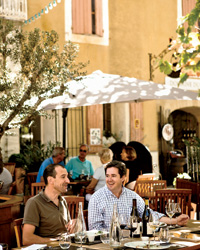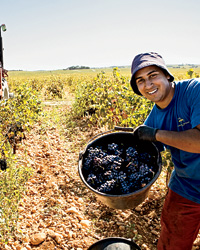The drive from the Priorat to Châteauneuf-du-Pape takes you from dusty and scruffy (Gratallops) to drab and industrial (the northern outskirts of Barcelona) to sunlit and idyllic (France’s Mediterranean coast). Four hours in, I was sailing along the E15 past Nîmes, under a glorious Provençal sun. To my right was the pastel-blue Mediterranean; to my left, maniacal French drivers, rocketing past me with fine Gallic disregard, even though I was doing 90 miles per hour.
Châteauneuf-du-Pape shares three important things with the Priorat: the sun, the Mediterranean and Grenache. The Priorat is a hardscrabble, impoverished region, despite the success of its wines; in contrast, the southern Rhône Valley, home to Châteauneuf, feels like an extension of Provence, all sparkling light, picture-postcard villages and gentle hills. The place is charming, not harsh. If a local farmer from the Priorat were to wake up here, he’d think he’d gone to heaven. At least until he realized everyone was speaking French.
I spent the night at a bed-and-breakfast; the next morning, I drove to Château de Beaucastel, one of the greatest producers of Châteauneuf-du-Pape. Marc Perrin, a lanky 41-year-old whose family owns Beaucastel, looked surprisingly relaxed—surprising since it was the middle of harvest and his wife had had a baby three weeks before. “I’m not getting much sleep,” he admitted.
 Châteauneuf du Pape tasting at L’Oustalet. Photo © Martin Morrell.
Châteauneuf du Pape tasting at L’Oustalet. Photo © Martin Morrell.Beaucastel, unlike Palacios, is open to visitors by appointment, and the Perrins also own L’Oustalet, a tree-shaded restaurant with a great wine list in the nearby town of Gigondas. I had a superb alfresco lunch there with Perrin, but even so, the transcendent moment of this visit for me was back at the winery, tasting five vintages of Beaucastel’s great Châteauneuf-du-Pape. We tasted the 2009, 2008, 2001, 2000 and 1990. All were remarkable, but the 1990 soared above the rest. It had a transparent, dark ruby hue, with a tremendously complex flavor that kept sounding different notes: truffle, sandalwood, black cherry, cured meat, a little bit of black olive.
“There have been vines growing here since Roman times,” Perrin told me, “but my family purchased the estate in 1909. We’ve been organic since 1950, and working biodynamically since 1974, but we never claim it on the bottle. It’s like something my uncle used to say: ‘Some people go to church just to be seen at church, and others go simply because they believe.’”

Ray Isle’s wine road trip takes him from Spain’s Priorat to Châteauneuf-du-Pape in France. Photo © Martin Morrell.
No comments:
Post a Comment